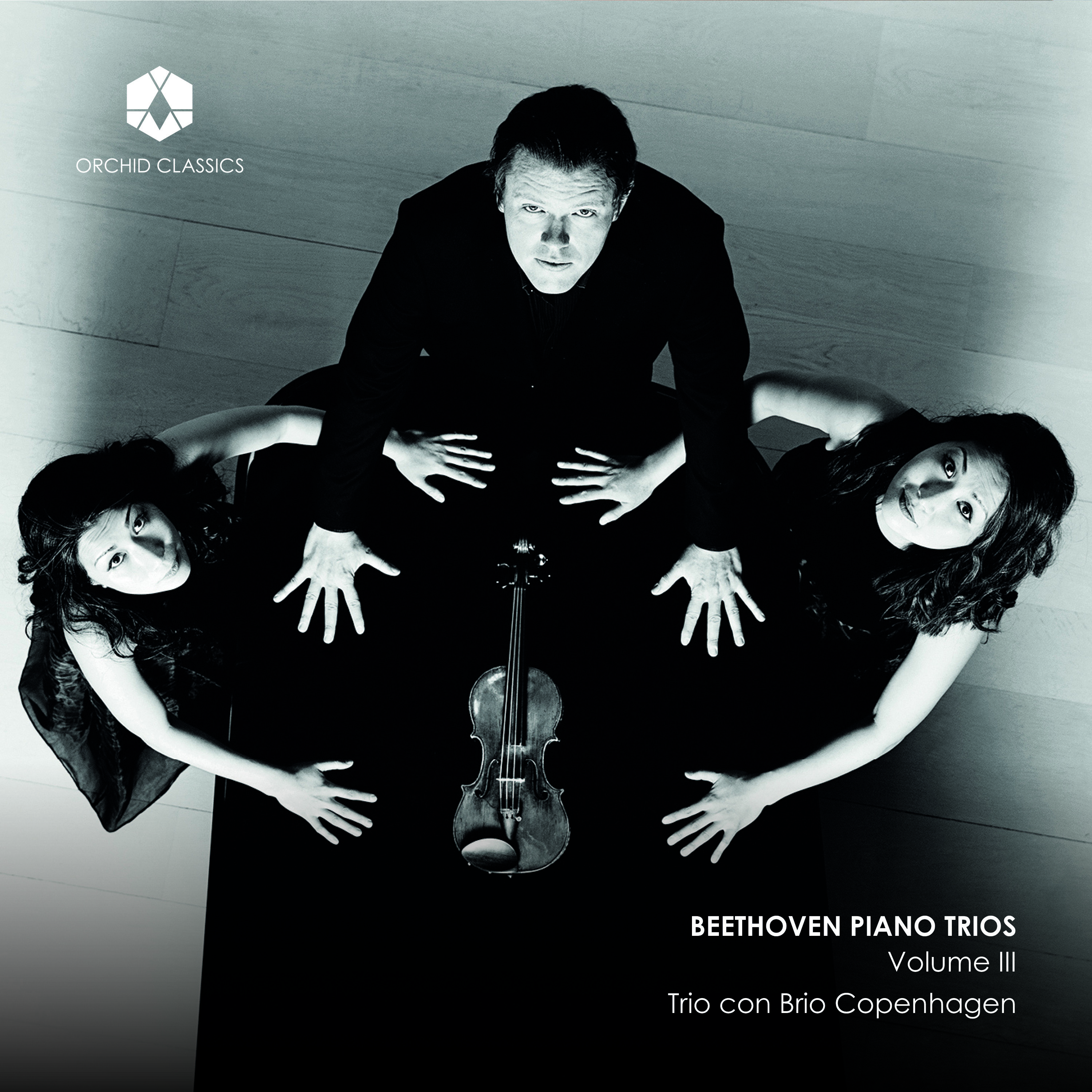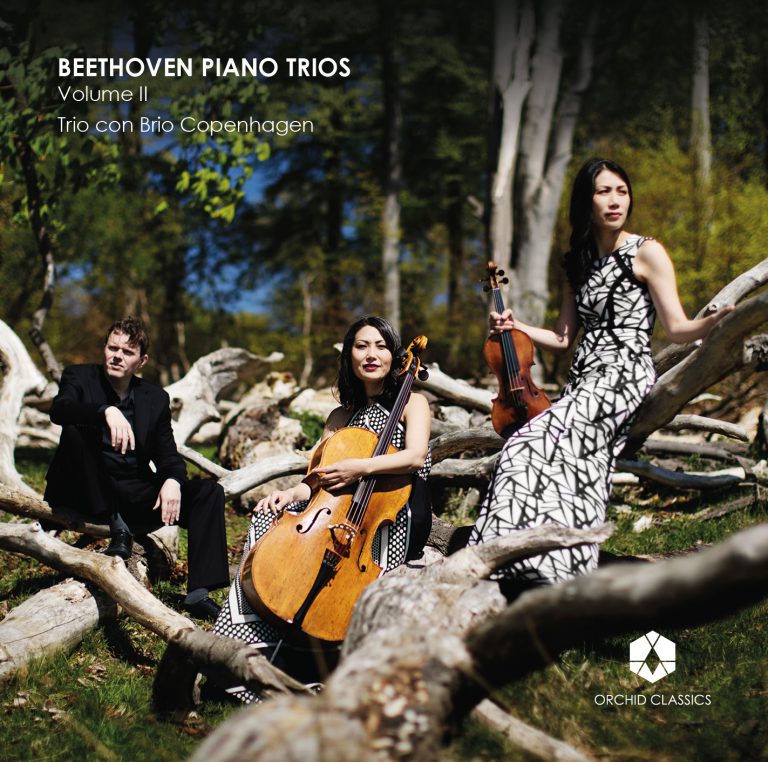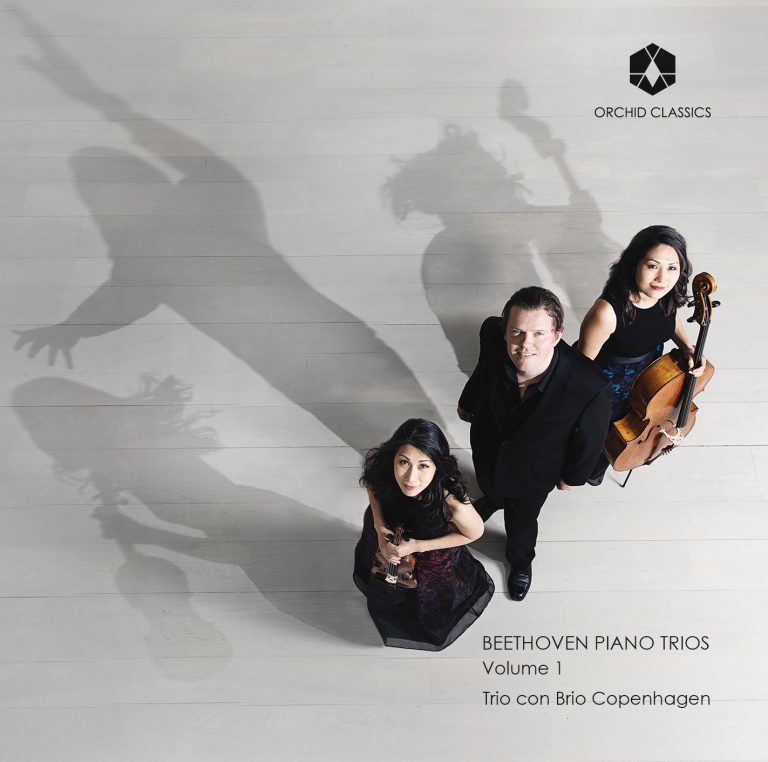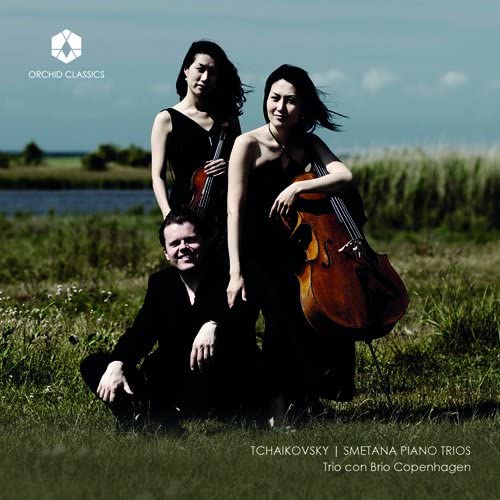Artist Led, Creatively Driven

Beethoven Piano Trios
Volume III
Trio con Brio Copenhagen
Release Date: June 21st 2019
ORC100101
LUDWIG VAN BEETHOVEN (1770-1827)
PIANO TRIOS VOLUME III
Piano Trio in C minor Op.1 No.3
1 Allegro con brio 9.49
2 Andante cantabile con variazioni 8.05
3 Menuetto. Quasi allegro 3.39
4 Finale. Prestissimo 7.34
Piano Trio in B flat major Op.97 “Archduke”
5 Allegro moderato 13.07
6 Scherzo. Allegro 6.43
7 Andante cantabile ma però con moto 12.11
8 Allegro moderato 6.53
Total time 68.19
Trio con Brio Copenhagen
Soo-Jin Hong, violin
Soo-Kyung Hong, cello
Jens Elvekjaer, piano
Beethoven at his Zenith
Beethoven’s temperament was legendary. He often ended up quarrelling bitterly with his closest friends and with people who wished him well. Particularly the relation between Beethoven and Haydn would appear to have been especially complex. When Beethoven leaves his native city of Bonn in favour of Vienna in autumn 1792, his intention is to study under Haydn, who is now 60 and the most highly recognised composer of his age. But even though Haydn agreed to teach the young, talented Beethoven, the two never established a harmonious relationship. Beethoven was impatient and frustrated at having to spend time on elementary counterpoint assignments, and Haydn became irritated at Beethoven’s obstinacy, referring to him as, among other things, ‘the great mogul’.
One of their greatest musical disagreements would seem to have been about the Piano Trio in C minor, Op.1 No.3. According to Beethoven’s later pupil Ferdinand Ries, Haydn did not think that it would be understood and received sufficiently positively by an audience. Throughout his life, Haydn had developed a sophisticated flair for composing original music which at the same time also satisfied the expectations of his musical employers. Beethoven, on the other hand, had revolutionary blood in his veins. Apart from his fractious temperament, he was an exponent of a new age, one in which personal liberty played an increasingly important role.
In the first two piano trios, with the binding designation opus 1, Beethoven had admittedly not only created a perfect springboard for excelling as a pianist but also kept within the norms that applied to Viennese salons. But in the third and last trio from the opus Beethoven shows his musical hand. Here for the first time we experience the germination of the radical Beethoven who is subsequently to change musical history. The darkly coloured main theme of the first movement, which is heard from the very beginning, smoulders with unreleased tension and is in C minor, which will later prove to be Beethoven’s preferred key signature when he wants to express something stormy and heroic. This particularly applies to Symphony No. 5 “Fate” and as an omen of this there is the fateful ta-ta-ta-taaaa knocking leitmotif in the form of a descending scale in the trio. At first, only softly in the piano after the pulse of the music has been suspended twice in a pause, and then loudly in the two strings.
Towards the end of the movement the fateful theme occurs once more. After Beethoven has thinned out the music to its softest nuances, he creates with an inserted Adagio a quiet moment of eternity which only dissolves when the piano comes in with the theme. This has the character of a life-giving impulse and leads on to a violent conclusion where the initial C minor, full of presentiment, now shows itself in its most unrelenting form. It is music that carries its head erect, blindly convinced of its own greatness.
In the following two movements, Beethoven leads the listener into milder zones. In Andante cantabile con variazioni the classical balance is regained. With delicate composition that offers plenty of scope for brilliance, the musical material is broken down into ever smaller constituents until an entrancingly beautiful minor variation causes the music to rise above time and place. Beethoven the man’s dream of divine beauty can be glimpsed on the horizon. And even though the following Menuetto, with its ingenious play of rhythms, is beyond the regular pattern of the baroque, everything is done with elegance and humour.
This only serves to increase the effect of the final movement Finale, which is charged with volcanic force and where the music at no point calms down. One of Beethoven’s artistic effects is the pause, which causes the intensity to increase, as the music subsequently changes track when the rocket-like thematics of the beginning are replaced by hectically repeated notes. Towards the conclusion the movement thins out, but the unrest continues, for although the music becomes softer, the feverish pulse remains intact until the very end. So that even after the last note, the musical fervour can still be sensed. The extent to which the music is over or not is something Beethoven leaves the individual listener to decide.
Beethoven’s last Piano Trio in B flat major, Op.97 ‘The Archduke’ marks Beethoven’s farewell as a pianist. At the first performance in April 1814 in Vienna, where Beethoven sat at the piano, he played for the last time in public. His fellow composer Louis Spohr was present at the rehearsals for the concert: ‘As a result of his deafness, Beethoven had lost most of the virtuosity for which he had earlier been admired. In the forte passages the poor deaf man hammered away so the strings rattled, and in the piano he played so softly that whole clusters of notes were missing, so one lost the thread unless one was able to see the piano part at the same time. I was seized with great sorrow at such a tragic fate. Even if it is a great misfortune for anyone to become deaf, how can a musician bear this without falling into utter despair? Beethoven’s almost constant melancholy was no longer a mystery to me.’
But at the same time as Beethoven bids farewell as a performing musician, he opens the door to a different, greater world. In The Archduke Trio Beethoven’s art – when it comes to chamber music – is at its zenith. The three instruments are treated more equally, since the cello plays a more prominent role and the violin is in a slightly lower register than formerly, which results in a specially warm and full-bodied sound. And with the opening singing theme, which develops with calmness and dignity in the piano, the opening movement, epic in length, is intoned. The struggle and eternal striving for change, which otherwise is a strong characteristic of Beethoven’s music, is here laid aside. Instead, we meet a Beethoven who is capable of giving himself peace and simply being present in enjoying the moments of music.
Even in a long pizzicato section, where all three musicians must tiptoe through a distant harmonious twilight landscape, Beethoven underplays rather than the opposite. And the path out to a recalling of the golden harmonies of the opening passes through a no man’s land closely ornamented by ghostlike trills in all three instruments. The effect is tremendous, despite the subdued style, and the feeling of being in the presence of a mature artist is striking.
In the following Scherzo we meet Beethoven’s former musician-like ego. The theme that is flung out by the cello and wittily commented on by the violin is dancing and playful. But the form is complex, as in Beethoven’s symphonic scherzos. The first part of the trio, which breaks with the light feel of the opening, is particularly striking. With a slowly advancing theme, first heard in the cello, we move into a devious musical landscape where we have lost our footing, both rhythmically and harmonically. The usual feeling of a musical centre of gravity has been suspended, and we are drawing near to an aesthetics developed by the composers of the Second Viennese School a century later.
The third movement is a hymn that points the way to a metaphysical world. This is partly due to the choice of the key of D major, which exists in a different sphere of the harmonic system than the main key of B flat major, and partly to the floating-free feel of the music. The tranquil triple time is reminiscent of the old stately court dance the Sarabande, which here assumes a solemn, ceremonial nature. Ably assisted by the mild major sounds, it is the love-filled humanist Beethoven who is speaking to us. After a total of four richly developed variations, we return to the opening theme, although this time in a more porous form, and after a few bars the music starts to dissolve. But out of the last dying notes Beethoven creates a musical transformation. The notes that have just perished are reborn in a murmuring, romantically coloured music that wells up before the movement comes to rest in pure harmony.
It turns out, nevertheless, to be an illusion, for with a slight shift of a few notes Beethoven punctures the elevated mood and we find ourselves once more in the more down-to-earth B flat major, where a primitive and boldly dancing theme reminds one of the street urchins Beethoven used to meet daily in the metropolis of Vienna. Now the finale is in full swing, and with a virtuoso movement that towards the end culminates in a Più presto – even faster – Beethoven the pianist sends us a final greeting, and allows a joie de vivre to triumph even so.
Trio con Brio Copenhagen and Esben Tange
Trio con Brio Copenhagen
“Glowing reports hold true. The Trio con Brio Copenhagen clearly occupies a lofty perch in today’s musical scene.” Washington Post
“From the first note, Trio con Brio exudes class…both explosive and exquisitely intimate – aspects that this performance delivers with compelling panache.” Strad
Founded in Vienna in 1999 with the concept of pairs coming together, the two Korean sisters, and Soo-Kyung and Jens (who are now married), have since then been exploring the piano trio repertoire with freshness and curiosity as well as with respect and reflection. In particular they have been gaining a reputation for the freshness of their approach to the core repertoire: “works by Beethoven, Schubert and Brahms are transformed in their hands into the alive-and-kicking music of today” (Esben Tange, editor at DR P2).
Since its inception the Trio has won most of the international competitions for piano trio, including the ARD (Munich), Vittorio Gui (Florence) and Norway’s Trondheim Competition. In January 2015 the Trio became the first ensemble to receive one of Denmark’s most prestigious music awards, the “P2 Artists Prize,” at a live televised concert where they performed Beethoven’s Triple Concerto with the Danish National Symphony Orchestra. Other major awards received include the Kalichstein-Laredo-Robinson International Trio Award (USA) and the “Allianz Prize” in Germany’s Festspiele Mecklenburg-Vorpommern.
Trio con Brio Copenhagen is in great international demand and has an intensive worldwide touring schedule. Recent and future appearances include Washington DC, New York City, Los Angeles, Seoul, London, Hamburg, Heidelberg, Paris, Stockholm, Oslo and Copenhagen among many other cities. In recent years, Trio con Brio Copenhagen has appeared in major concert halls in Europe, the USA and Asia, such as Tivoli Concert Hall, Concertgebouw, Carnegie Hall, Lincoln Center, Wigmore Hall, Elbphilharmonie Hamburg, Konzerthaus Berlin, Louvre Paris, Théâtre de la Ville Paris, Seoul Arts Center, Bunka Kaikan Tokyo, and Teatro Olimpico Vicenza.
Trio con Brio Copenhagen continues to play a central role in Scandinavia’s vibrant contemporary music scene. Several of Denmark’s most prominent composers including Per Nørgård and Bent Sørensen, as well as Swedish composer Sven-David Sandström, have composed and dedicated works to the Trio. Trio con Brio Copenhagen was enormously honoured to be chosen by Per Nørgård to be the dedicatee of a work that was premiered at a festival in Stockholm celebrating his 80th birthday in 2012. In January 2016 the trio presented the world premiere of Bent Sørensen’s Triple Concerto with the Danish National Orchestra for which Bent Sørensen was awarded the prestigious Grawemeyer Award in 2017.
The Trio’s recordings have been praised by critics. American Record Guide wrote: “One of the greatest performances of chamber music I’ve ever encountered…”. Gramophone Magazine wrote: “…Any group would be hard-pressed to imitate this blend of verve and poise…”. Their Mendelssohn CD was chosen by Classic FM, UK as Chamber Disc of 2011: “Every phrase soars and pulsates with the excitement of a fresh discovery as the Copenhagen players go the full distance with playing of skin-rippling sensitivity…sensational playing…”. Their latest recording of trios by Tchaikovsky and Smetana was hailed by The Guardian (UK): “…Trio con Brio Copenhagen scale the Tchaikovsky’s heights with the verve their name suggests…”
Trio con Brio Copenhagen is frequently featured as soloist in Beethoven’s Triple Concerto with orchestras. In 2011 the Trio premiered a new Triple Concerto by the renowned Swedish composer Sven-David Sandström with the Danish National Symphony Orchestra and Kristjan Järvi in Copenhagen’s Koncerthuset. The following year, they were invited to perform the Triple Concerto with the Stockholm Philharmonic Orchestra for Sandström’s 70th birthday concert in the Stockholm Konserthus.
The Trio is artistic director of the Copenhagen Chamber Music Festival, the Chamber Music Festival on Lundsgaard Estate in Kerteminde and the Hellerup Chamber Music Society in Copenhagen.
The Trio’s sound benefits from the superb instruments they play: Soo-Jin plays a violin built by Andrea Guarneri from the 17th century, Soo-Kyung plays a Grancino cello, and Jens is Denmark’s first Steinway Artist. Both string players are endorsed by Jagar Strings and Thomastik-Infeld Vienna.
The ensemble was coached by the Alban Berg Quartet, Frans Helmerson, Mihaela Martin and Harald Schoneweg at the Cologne University of Music and received excellent musical guidance by Ferenc Rados in Budapest.
More information is available on Trio con Brio Copenhagen’s website:
www.trioconbrio.dk









